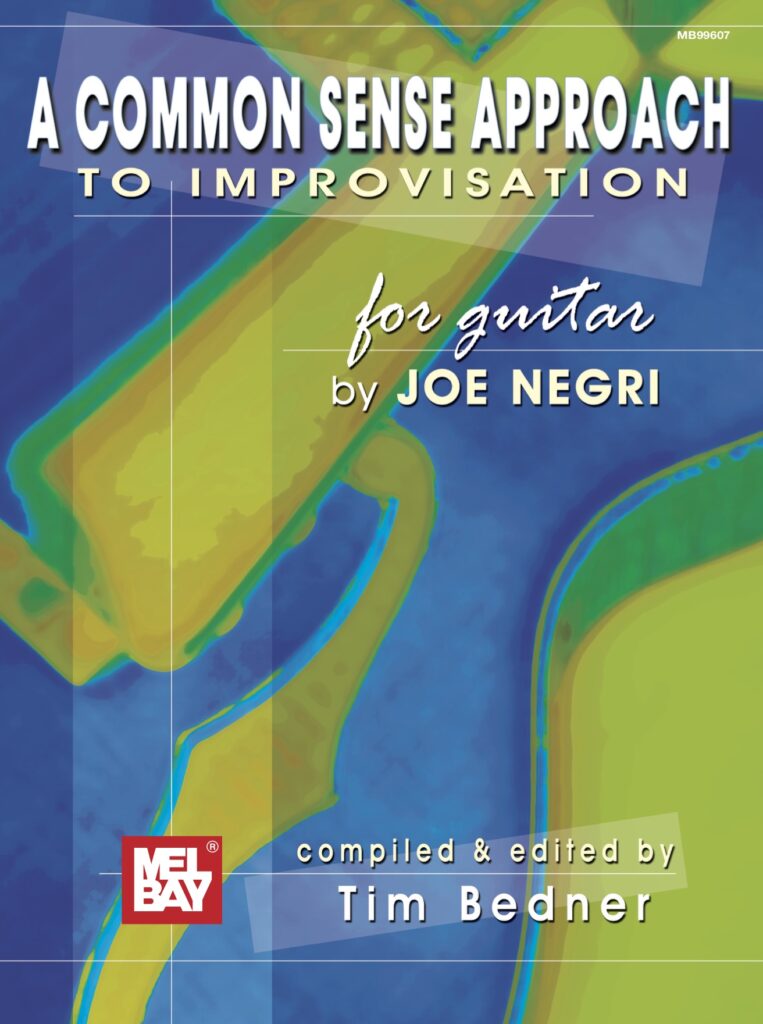
A few years ago, I got this Joe Negri book from the Mel Bay website. I looked through it and tried most of the exercises but didn’t really get into it. Recently while looking for another book, I came across this book in the same folder and decided to revisit it.
Joe Negri’s approach is definitely as the title describes!
Perhaps in a nutshell, if I had to explain the book, Joe basically boils down learning to improvise in a jazz guitar context to learning triads on the 4th, 3rd and 2nd string.
He says that, “I have chosen the middle range of the guitar using string-grouping 4-3-2 because of the tonal quality of that register. It falls within the tessitura of the instrument, to borrow a term from vocal pedagogy.”
This is interesting because of how he decided to use the tonal quality of the guitar as a way of approaching improvisation, and then only later on expanding the range to include the other remaining registers.
The book begins with a discussion of this topic and then goes into major, minor and 3-note dominant 7th inversions. Then, he introduces different cadences that happen in music before teaching us how to build single note lines from the previous materials. Joe also explores some guitaristic phrasing devices including sweep picking and slurs.
Expanding on the materials, Joe also goes into what he calls secondary harmony and ending with lines around the II-V-I progression. Closing the book Joe gives two 8-measure examples that show how the previous melodic ideas could work in two common jazz standards. You are also asked to write your own melodic lines to those two chord progressions.
The book is really a practical exploration of triads, basic cadences and creating melodic lines in the swing and bebop tradition. It’s doesn’t go in-depth but certainly gives us enough to work on.
In conclusion, this 41-page book is a slim volume but has some important key ideas that are helpful for shaping improvisation within a harmonic tonal context. Is it a must-buy? Maybe not. But is it a good book for the curious guitar pedagogy completist? I certainly would say yes.
Pros: Important concepts explained in a concise way, main exercises are written in all 12 keys.
Cons: Some might feel the book doesn’t have enough material to dig into.
TLDR: This books feels like a collection of private lesson notes in a way, but structurally still works and gives an interesting way to approach learning jazz improvisation.
Get your copy from Amazon and from the Mel Bay website.
[Review Archive]
I wrote a lot of other book, course and video reviews too.
Check out the rest here:
[Read more reviews]
[Submissions for Review Consideration]
- Are you an author who wrote a jazz, guitar or music book?
- Have you created a DVD or an online video course or subscription based website?
- Would you like me to review your book/course?
Please send me a message at azsamad3 at gmail.com with:
For courses: a link to the course/video/product + access info etc.
For books: a link to the book (Dropbox) or PDF attachment (if it’s small) for review consideration.
Depending on whether I dig the book/course, I’ll let you know if I do plan to review it!
I cannot guarantee a review for every submission & if I’m not too into it, I may opt not to review it. I mean, it’s better to get a good review that for me to write a bad review just because it’s not a match for the kind of stuff I dig right? :p
NOTE: All reviews reflect my honest personal opinion so be aware that I will point out both cool Pros and Cons that I see in the work. You dig?